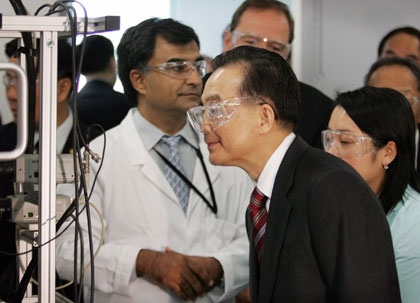China overtaking Japan in R&D spending
(AP)Updated: 2006-12-05 13:18
China should surpass Japan this year to become the world's No. 2 investor in research and development after the United States, an international economic group said Monday.
China is expected to spend just over US$136 billion on R&D in 2006, passing Japan's forecast US$130 billion, the Paris-based Organization for Economic Cooperation and Development said in a report on world technology trends.
 Chinese Premier Wen Jiabao (C) visits Woodside Hydrocarbon research facility at Curtin University in Perth, Australia April 2, 2006. [Reuters]  |
Chinese companies and the government are spending heavily on trying to create new technologies in areas from telecommunications to biotech. They're also trying to reduce reliance on foreign know-how, which the Chinese leaders see as a strategic weakness.
"The rapid rise of China in both money spent and researchers employed is stunning," Dirk Pilat, head of the OECD's science and technology division, said in a statement.
Among other Asian economies, South Korea's research spending ranked seventh worldwide at about US$24 billion, followed closely by India, the OECD report said. It said the region of Taiwan was in 12th place at US$15 billion.
The rise in Chinese spending has been fueled by economic growth that is expected to top 10 percent this year.
Chinese President Hu Jintao and other leaders have called for China to become an "innovation society," boosting the role of technology in driving growth and reducing reliance on investment and low-wage industries.
The Cabinet or the State Council issued an ambitious 15-year plan in February that called for making innovation the engine of China's growth by pushing development of 11 key areas ranging from lasers to nuclear power and genetics. It promised to support private research with tax breaks and improved patent and copyright protection.
China's research and development spending as a percentage of its economic output has more than doubled to 1.3 percent, up from 0.6 percent in 1995, according to the 252-page OECD report, "Science, Technology and Industry Outlook." It said research spending is growing even faster than the overall economy.
Two-thirds of Chinese research spending this year is expected to come from industry and one-third from the government, the report said. However, that distinction is blurred in a system where big research spenders are state-owned companies carrying out official mandates.
The 30-nation OECD includes the United States, Japan and most European Union members. China is not a member.
The Chinese plan issued last February called for raising total research spending still further to 2 percent of economic output by 2010 and 2.5 percent by 2020.
"China's plan to become a major innovation economy by 2020 is probably the most significant (among developing countries) as it will launch a series of reforms and strategic projects to make research and innovation the motor of its new economic development strategy," the OECD report said.
It isn't clear, however, how effectively China's research spending is being used.
In May, the government suffered an embarrassing setback when a scientist at a leading Shanghai university was revealed to have faked research on a computer chip that state media had hailed as a major breakthrough.
The number of Chinese researchers has soared by 77 percent over the past decade to 966,000, ranking second behind the United States' 1.3 million and ahead of Japan's 677,000, the OECD report said.
Still more Chinese scientists work abroad due to lack of opportunity at home. Beijing is trying to lure them back by expanding university labs, opening research parks and offering quick promotions to returning academics.
The nearly 15,000 Chinese scientists in the United States make up the largest group of foreign researchers there, the OECD report said.
|
||
|
||
|
|